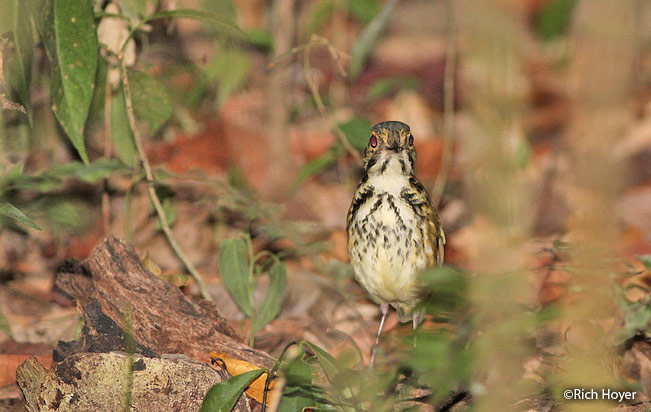Order: Passeriformes | Family: Grallariidae | IUCN Status: Least Concern

Age: Adult | Sex: Unknown | Loc. Mato Grosso, Brazil

Age: Adult | Sex: Unknown | Loc. Mato Grosso, Brazil

Age: Adult | Sex: Unknown | Loc. Mato Grosso, Brazil

Age: Adult | Sex: Unknown | Loc. Mato Grosso, Brazil
Identification & Behavior: ~14 cm (5.5 in). The Spotted Antpitta has a gray cap and nape with brown upperparts with faint wing bars. The underparts are white black streaks across the breast. The sides and flanks are rusty with faint black streaks. It has a broad rusty eyering. The Spotted Antpitta is similar to the White-lored Antpitta with which is likely to overlap in part of its range. The Spotted Antpitta is distinguished by a broad rusty eyering versus white lores and white crescent behind the eye in the White-lored Antpitta. Also, see Thrush-like Antpitta.
Status: The status of the Spotted Antpitta is poorly understood in Peru. Most records come from localities along the Amazon, lower Marañon, and Tigre Rivers. It may range wider. It also occurs in Co, Ec, Br, and Bo.
Name in Spanish: Tororoi Moteado.
Sub-species: Spotted Antpitta (Hylopezus macularius diversa) J. T. Zimmer, 1934.
Meaning of Name: Grallaria: L. grallarius, grallae= one walking on stilts. macularius: L. macula= tinted, stained, stain.
Distribution Map
 Voice
Voice
 Voice
VoiceReferences:
-
- Species range based on: Schulenberg, T. S., D. F. Stotz, and L. Rico. 2006. Distribution maps of the birds of Peru, version 1.0. Environment, Culture & Conservation (ECCo). The Field Museum. http://fm2.fieldmuseum.org/uw_test/birdsofperu on 01/01/2015.